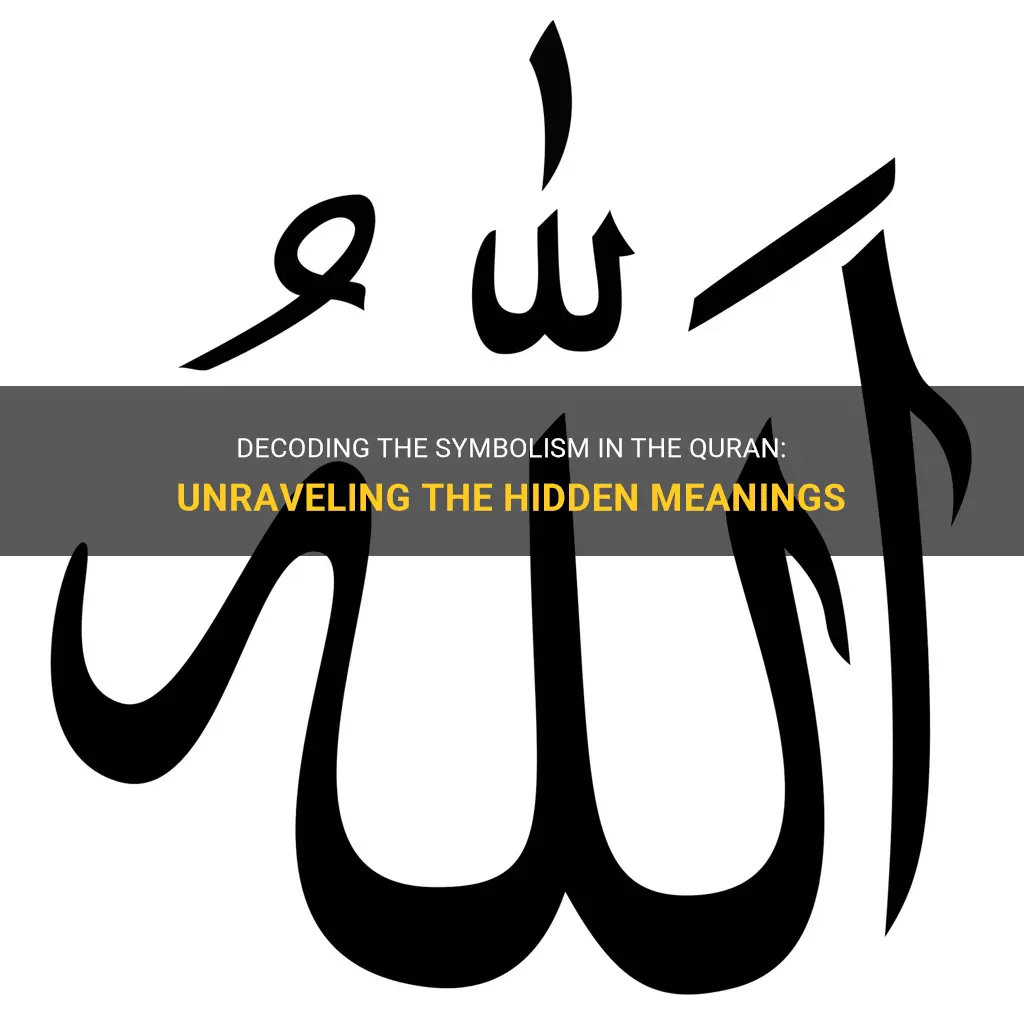
The Quran is not just a holy book for Muslims, it is also filled with symbols and meanings that reflect the core beliefs and teachings of Islam. These symbols are often overlooked or misunderstood, but they play a crucial role in understanding the depth and complexity of the Quranic text. Whether it's the recurring themes of water, light, or numbers, each symbol holds a profound significance that offers spiritual guidance and enlightenment to its readers. In this article, we will explore some of the most intriguing Quran symbols and delve into their deeper meanings, shedding light on the rich symbolism that enriches the Islamic faith.
What You'll Learn
- What is the significance behind the symbols found in the Quran?
- How are these symbols interpreted by different scholars and sects?
- Are there any specific symbols in the Quran that have multiple meanings or are open to interpretation?
- Have the meanings of these symbols changed or evolved over time?
- How do these symbols enhance the overall understanding and interpretation of the Quranic text?

What is the significance behind the symbols found in the Quran?
The Quran, the holy book of Islam, is revered by millions of people around the world. It is believed to be the word of God as revealed to the Prophet Muhammad by the angel Gabriel. The Quran is not just a text to be recited and followed, but also a book filled with symbols and signs that hold deep spiritual and mystical meanings. These symbols are found throughout the Quran and are believed to provide deeper insights into the teachings and messages contained within.
One of the most significant symbols found in the Quran is the number seven. The number seven is mentioned numerous times in the Quran, and it holds great importance in Islamic tradition. It is believed to represent completeness and perfection. For example, there are seven heavens, seven earths, and seven days of creation. This symbolizes the divine order and harmony in the universe.
Another important symbol in the Quran is the symbol of light. Light is often used metaphorically to represent knowledge, guidance, and spiritual enlightenment. In many verses of the Quran, God is described as the light of the heavens and the earth. The symbol of light signifies the enlightenment and spiritual awakening that can be attained through the teachings of the Quran.
Water is another powerful symbol found in the Quran. It is often associated with life, purity, and the spirit. In the Quran, water is mentioned in various contexts, such as the creation of life, the purification of the soul through ablution, and the sustenance of all living creatures. Water symbolizes the life-giving and cleansing properties of the Quran's teachings.
Another symbol that holds great significance in the Quran is the symbol of the heart. The heart is believed to be the center of spirituality and the source of faith. It is often mentioned in the Quran as the seat of intellect, emotions, and consciousness. The heart symbolizes the connection between God and the individual, as well as the receptivity and openness to divine guidance.
In addition to these symbols, the Quran is filled with rich imagery and metaphors that convey profound spiritual truths. For instance, the Quran uses imagery of gardens, rivers, and paradise to describe the rewards awaiting the righteous in the afterlife. These symbols evoke feelings of beauty, peace, and abundance, and serve as a reminder of the ultimate goal of the believers.
The symbols found in the Quran are not mere decorative elements, but rather profound metaphors that communicate deeper truths and realities. They are meant to inspire contemplation, reflection, and spiritual growth. By understanding and meditating upon these symbols, believers can gain a deeper understanding of the Quran's teachings and connect with its timeless wisdom.
The Intricate Symbolism and Meaning Behind Beads
You may want to see also

How are these symbols interpreted by different scholars and sects?
Symbols have always played a significant role in various religions and belief systems. They are often used to represent abstract concepts or ideas and can hold different interpretations among scholars and sects. Let's take a look at how these symbols are interpreted by different scholars and sects across different religions.
In Christianity, the cross is one of the most widely recognized symbols. It represents the crucifixion of Jesus Christ and his sacrifice for humanity. While this interpretation is common among most Christian sects, the specific shape and design of the cross can vary. Some sects interpret the cross as a symbol of victory over death, while others focus on the idea of redemption and salvation.
Another important symbol in Christianity is the fish, which is often referred to as the "Jesus fish" or Ichthys. This symbol dates back to the early days of Christianity when followers faced persecution. It was used as a secret symbol to identify fellow Christians. Today, the fish is interpreted as a symbol of faith and the belief in Jesus as the Son of God.
Moving on to Islam, the crescent moon and star are widely recognized symbols. The crescent moon represents the lunar calendar followed by Muslims, while the star is associated with the birth of Prophet Muhammad. However, the interpretation of these symbols varies among different scholars and sects. Some see them as purely cultural symbols with no religious significance, while others view them as symbols of the divine presence and blessings.
In Hinduism, the Om symbol represents the ultimate reality or Brahman. It is often chanted during meditation and is believed to encompass the entire universe. Different interpretations of the Om symbol exist among Hindu scholars and sects. Some interpret it as a representation of various Hindu deities, while others see it as a symbol of the fundamental vibration or sound of the universe.
The yin-yang symbol, commonly associated with Taoism, represents the balance between opposing forces such as light and dark, feminine and masculine, and passive and active. While this interpretation is widely accepted, there are variations in how the yin-yang symbol is interpreted among different Taoist scholars and sects. Some emphasize the idea of harmony and balance, while others focus on the interdependent nature of these opposing forces.
Lastly, in Buddhism, the lotus flower is widely recognized as a symbol of enlightenment, purity, and spiritual growth. It is often depicted as emerging from muddy water, symbolizing the ability to rise above worldly desires and attachments. Different scholars and sects interpret the lotus flower symbol in various ways. Some emphasize its connection to the Buddha's teachings and the path to enlightenment, while others see it as a representation of spiritual potential within all beings.
Overall, symbols hold great significance in various religions and belief systems. While there may be differing interpretations among different scholars and sects, these symbols serve as a means of expressing and understanding abstract concepts and ideas. They can inspire faith, guide spiritual practices, and foster a sense of unity among believers.
Exploring the Intricate Symbolism and Meaning behind BDSM Symbols
You may want to see also

Are there any specific symbols in the Quran that have multiple meanings or are open to interpretation?
In the holy Quran, the scripture of Islam, there are several symbols that are open to interpretation and may have multiple meanings. These symbols are often used to convey spiritual or moral concepts, and their interpretations can vary depending on the perspective of the reader.
One of the most well-known symbols in the Quran is the "light." Light is frequently used as a metaphor for guidance, knowledge, and enlightenment. It represents the divine presence and is often associated with Allah's mercy and blessings. However, the symbol of light can also have deeper meanings. It can signify wisdom, purity, and the path towards righteousness. The concept of light in the Quran is open to interpretation, and different readers may derive different symbolic meanings from it.
Another important symbol in the Quran is the "water." Water is mentioned throughout the Quran as a symbol of life, purification, and sustenance. It is often associated with Allah's mercy and blessings, as it is the source of all living beings. Water is also used metaphorically to represent spiritual purification and the cleansing of one's soul. However, water can also be seen as a symbol of destruction, as it is mentioned in contexts such as the story of Noah's flood. Thus, the symbol of water in the Quran has both positive and negative connotations.
The "mountain" is another symbol that appears in the Quran and carries various meanings. Mountains are often used to symbolize strength, stability, and the majesty of Allah's creation. They represent the power and grandeur of the divine and remind believers of their own insignificance in comparison. Mountains can also signify barriers or obstacles in one's spiritual journey, emphasizing the need for perseverance and determination. The interpretation of mountains in the Quran can vary depending on the context in which they are mentioned.
An additional symbol in the Quran is the "garden." Gardens are used to symbolize paradise, the ultimate reward for the righteous believers. They represent beauty, abundance, and eternal bliss. Gardens in the Quran are often described as lush and filled with fruits, rivers, and shade, providing comfort and pleasure to those who enter them. The symbol of the garden can also signify the rewards of faith and the fulfillment of one's spiritual journey.
It is important to note that while these symbols carry significant meanings in the Quran, their interpretations may vary among different scholars and readers. The Quran itself encourages a deep reflection and contemplation of its verses, allowing individuals to derive personal insights and understandings. Thus, the symbols in the Quran are open to interpretation and can have multiple meanings depending on one's spiritual journey and perspective.
Unraveling the Mystical Meaning and Symbolism Behind Shooting Stars
You may want to see also

Have the meanings of these symbols changed or evolved over time?
Symbols have been used by humans for thousands of years to convey meaning and communicate information. From ancient cave paintings to modern digital icons, symbols have played a crucial role in human society. But have the meanings of these symbols changed or evolved over time?
The answer to this question is not a simple one. While some symbols have remained relatively unchanged in their meaning, others have definitely evolved and taken on new connotations as societies and cultures have changed over time.
One example of a symbol that has retained its meaning throughout history is the heart symbol. The symbol of a heart has long been associated with love and affection. It can be traced back to ancient Greek and Roman times when it was believed to be the center of emotions and the seat of the soul. This meaning has remained consistent throughout the centuries, and the heart symbol is still widely recognized as representing love and romance today.
On the other hand, some symbols have definitely evolved and taken on new meanings over time. The swastika symbol is a prime example of this. Originally an ancient religious symbol in Indian culture, the swastika was used as a positive symbol representing good luck, prosperity, and well-being. However, with its adoption by Nazi Germany during World War II, the swastika has become synonymous with hate, racism, and genocide. The original meaning of the symbol has been overshadowed, and it is now widely recognized as a symbol of hate and intolerance.
Another example of a symbol that has evolved over time is the peace symbol. The peace symbol, often referred to as the "peace sign," was first designed in the late 1950s as a symbol of the British Campaign for Nuclear Disarmament. It quickly became associated with the anti-war and peace movements of the 1960s and was adopted as a universal symbol of peace and nonviolence. Today, the peace symbol is recognized globally as a representation of peace and is often used in protests and demonstrations advocating for peace and justice.
Symbols can also take on different meanings within different cultures and contexts. For example, the color red is often associated with danger or warning in Western cultures, while in Eastern cultures, it is associated with luck and prosperity. Similarly, the thumbs-up gesture is generally seen as a positive sign of approval in Western cultures, but in some countries, it can be seen as offensive or vulgar.
In conclusion, the meanings of symbols have definitely changed and evolved over time. While some symbols have remained consistent in their meaning, others have taken on new connotations as societies and cultures have changed. Some symbols have even become associated with negative or positive meanings depending on the context. As our world continues to evolve, it is likely that symbols will continue to shift and adapt to reflect the changing values and beliefs of society.
Decoding the Dark: Unraveling the Meaning Behind Bad Omens Band Symbols
You may want to see also

How do these symbols enhance the overall understanding and interpretation of the Quranic text?
Symbols play a significant role in enhancing the overall understanding and interpretation of the Quranic text. By using symbols, the Quran communicates complex ideas, emotions, and concepts in a concise and powerful manner. These symbols are woven into the fabric of the text, helping readers to grasp the deeper meanings and connections between various verses and chapters.
One of the most prominent symbols in the Quran is that of light. Light is used to represent knowledge, guidance, and the truth. In many verses, light is contrasted with darkness, symbolizing ignorance and falsehood. This symbol helps readers to understand that the Quran is a source of enlightenment and guidance, leading them towards the path of righteousness.
Water is another important symbol found throughout the Quran. Water symbolizes purification, renewal, and life. It is often associated with spiritual cleansing and the forgiveness of sins. The Quran uses water as a metaphor for the spiritual transformation that takes place when one commits themselves to the teachings and guidance of Allah.
Another symbol found in the Quran is the tree. Trees symbolize growth, strength, and sustenance. In the Quran, trees are used as a metaphor for the righteous believers, who are deeply rooted in their faith and whose actions bear fruits of goodness. This symbol helps readers to understand that a strong foundation of faith is essential for one's spiritual growth and success.
Animals are also used as symbols in the Quran to convey various messages. For example, birds symbolize freedom and the ability to ascend to higher spiritual planes. The story of the hoopoe bird in Surah An-Naml symbolizes the guidance and wisdom bestowed upon Prophet Solomon. Similarly, bees symbolize productivity, organization, and the importance of community. The Quran references bees as a symbol of the miraculous creation of Allah and encourages believers to reflect on the lessons they can learn from these creatures.
Symbols such as mountains, stars, and fire are used in the Quran to evoke awe, emphasize the power of Allah, and illustrate the consequences of one's actions. These symbols help readers to connect with the text on a deeper level, evoking imagery and emotions that enhance their understanding and interpretation.
Overall, symbols play a vital role in the Quran by enhancing the overall understanding and interpretation of its text. They serve as powerful tools that communicate complex ideas and concepts, helping readers to grasp the deeper meanings and connections within the verses. By using symbols such as light, water, trees, animals, and natural phenomena, the Quran engages readers on an intellectual and emotional level, inviting them to reflect, contemplate, and internalize its teachings. The use of symbols in the Quran enriches the reading experience and fosters a deeper understanding of its profound message.
Decoding the Hidden Symbolism of Kente Cloth: Exploring the Meaning Behind the Patterns and Designs
You may want to see also
Frequently asked questions
The moon symbol in the Quran is often used to represent various concepts, such as the passage of time, the lunar calendar, or as a metaphor for the fleeting nature of life. It can also be associated with the word "light" in religious context, symbolizing guidance or illumination.
In the Quran, the symbol of a hand is often associated with the concept of power or strength. It can represent the divine power of Allah, as well as the ability to bestow blessings or offer help. It is mentioned in various verses to symbolize the control and authority of Allah over all things.
The symbol of a scale in the Quran is often used to represent justice and fairness. It is mentioned in verses that emphasize the importance of balance and equal distribution of rights and responsibilities. The scale symbolizes the weighing of deeds on the Day of Judgment, where the actions of individuals will be evaluated and rewarded or punished accordingly. It serves as a reminder of the importance of living a just and righteous life.







